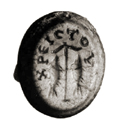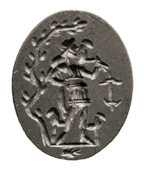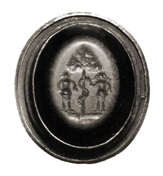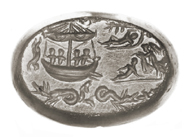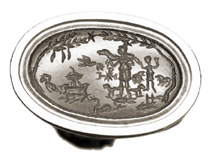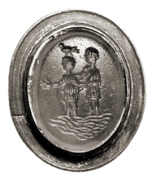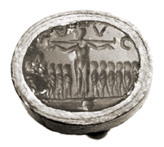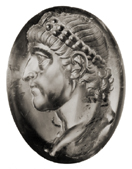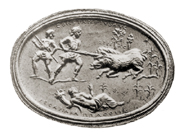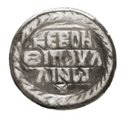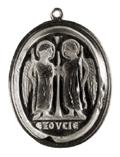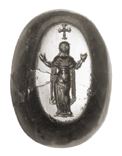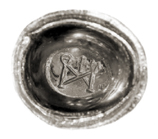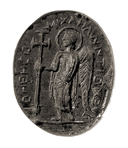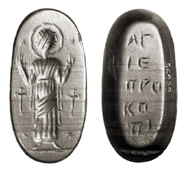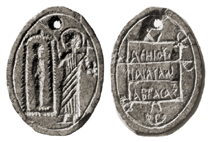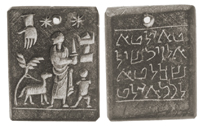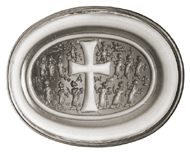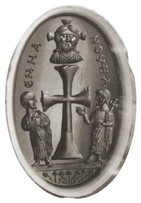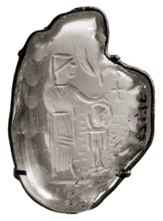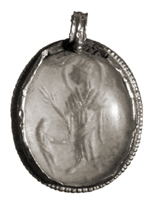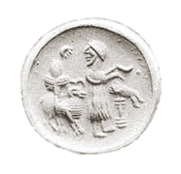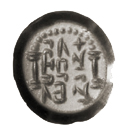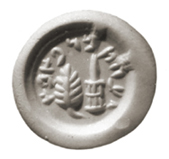Late Antique, Early Christian and Jewish gems
Introduction
Around the middle of the 3rd century AD gems engraved with Christian inscriptions and imagery first appeared in the Christian communities of the eastern Mediterranean. Identical to pagan gems in shape, material (usually cornelian, agate, or jasper), and engraving style, and likely produced by pagan gem cutters for their Christian clients, these gems bear distinctively Christian inscriptions or symbols, most notably the fish and the Good Shepherd. Soon afterward, narrative images were introduced, usually scenes from the Old Testament, such as Jonah and Daniel, which were given Christian interpretations. By the time the first Christian seals were introduced, however, the fashion for using engraved gems was waning. Although there was a brief revival under the Constantinian emperors, only a few workshops appear to have manufactured gems after the fourth century. One workshop produced fine garnets and sapphires at the end of the 5th century, and several distinctive groups of gems with religious iconography were cut in Asia Minor and Syria in the 5th and 6th centuries. In the East, within the Sasanian Empire (3rd to 7th centuries AD), where engraved gems remained very popular, the small Christian and Jewish communities also engraved seals.
Bibliography
O.M. Dalton, Catalogue of Early Christian Antiquities in the British Museum (London, 1901)
Ph. Gignoux, "Sceaux chrétien d'époque sasanide", Iranica Antiqua 15 (1980), 299-314
Genevra Kornbluth, "'Early Byzantine' Crystals: An Assessment", Journal of the Walters Art Gallery 52/53 (1994/95), 23-32
H. Leclercq, "Gemmes", DACL 6, 1 (1924), 794-864
Judith A. Lerner, Christian Seals of the Sasanian Period (Istanbul, 1977)
Shaul Shaked, "Jewish Sasanian Sigillography", in Au Carrefour des religions. Mélanges offerts à Philippe Gignoux. Res Orientales 7 (Leuven, 1995), 239-55.
Jeffrey Spier, "Late Antique Cameos c.A.D. 250-600", in M. Henig and M. Vickers, eds., Cameos in Context. The Content Lectures (Oxford, 1993), 43-54
Idem, "Early Christian Gems and their Rediscovery", in C.M. Brown, ed., Engraved Gems: Survivals and Revivals. Studies in the History of Art 54 (National Gallery of Art, Washington, 1997), 33-43
Idem, Late Antique and Early Christian Gems (Wiesbaden, 2007)
Inscriptions
Among the earliest Christian gems, datable to the mid 3rd century AD, are a number of small cornelians and jaspers engraved only with inscriptions naming or referring to Jesus Christ. Some read IHCOY XPICTOY, "of Jesus Christ" (in the genitive case, presumably meaning that the wearer was a "servant of Jesus Christ"), others merely IHCOY ("of Jesus") or XPICTOY ("of Christ"). Also used were the chi-rho monogram signifying "Christ" and the word IXQYC, meaning "fish" in Greek but also a frequently used acrostic composed of the first letters of "Jesus Christ, Son of God, Saviour".
Symbolic images (Fish and the Good Shepherd)
Another popular motif found on Christian gems of the later 3rd century is a pair of fish flanking an anchor or a cross-like object. Although the symbol is of pagan origin, attested first in the late Hellenistic period, its sudden appearance on gems in the 3rd century, as well as its occurrence in the Roman catacombs, demonstrates that Christians adopted the image, reinterpreting it as an allusion to Jesus (IXQYC). Some examples are labelled with explicitly Christian phrases.
Also appearing on gems of the later 3rd and 4th centuries is the image of the Good Shepherd. The shepherd is always shown carrying a sheep on his shoulders (the pose being that of the classical Greek kriophoros, but also a literal rendering of Luke 15:5), sometimes in a bucolic setting before a tree and with other sheep at his feet. Many of these gems have additional, explicitly Christian references, either inscriptions ("Jesus Christ", the chi-rho monogram, IXQYC, or some variant) or symbols, such as fish or anchors.
The Good Shepherd. An anchor is in the field and a fish in the exergue.
Oxford (Fortnum 89). Red jasper, 17 x 14 mm.
Old Testament scenes
Some Old Testament figures, notably Jonah and Daniel, enjoyed special popularity with Christians, who viewed them as symbols of salvation, prefiguring or alluding to Jesus. On a number of gems, the Good Shepherd is paired with Daniel, who typically is represented as standing in the pose of an orant (in prayer) between two lions. Other gems show the cycle of abbreviated images illustrating the story of Jonah: Jonah cast from the ship, swallowed by the great fish (always depicted as the classical ketos, or sea-monster), vomited out by the ketos, and lying asleep under the gourds. Less frequently represented on gems, and perhaps slightly later in date (4th century AD) are other Old Testament figures, including Adam and Eve, Noah, and Abraham's sacrifice of his son Isaac. A further group of gems combines various images, such as the Good Shepherd, Jonah, Daniel, and Noah.
Jonah, the Good Shepherd, Daniel and lions, dove with olive branch, and Christian monograms.
London, British Museum. Cornelian, 17.5 x 11 mm.
New Testament scenes
Only very few gems from the early Christian period (3rd to 5th centuries) survive that depict episodes from the New Testament. Surviving examples include representations of the Baptism of Jesus, the Raising of Lazarus, Peter and Paul, and three remarkable portrayals of the Crucifixion. The appearance of the Crucifixion on gems, in an unconventional composition which includes the twelve apostles, is significant for its early date, still in the 4th century if not earlier, for no other depiction of the Crucifixion is known until the 5th century.
The Crucifixion: Jesus and the twelve apostles, with the inscription IXQYC.
London, British Museum. Cornelian, 13.5 x 10.5 mm.
The Constantinian revival
A revival of gem cutting occurred early in the 4th century during the reign of Constantine the Great and his sons. A number of very fine gems survive, including some exceptionally large examples cut in rarer materials such as amethyst and sapphire. Most of these stones are engraved with portraits of the emperor, and no Christian narrative scenes are known.
Cameos
The Roman tradition of cutting cameos continued into the early Christian and Byzantine periods but in far fewer examples. Only a few large cameos with portraits of the Emperor and the imperial family survive, most dating from the Constantinian period. Most cameos of the late antique period (3rd to 6th centuries AD) are small and cut with simple acclamations ("May you live" or "Lord help"), often naming the owner. In the 6th century, some fine cameos depict religious images, notably the Annunciation and angels, while one unusual workshop produced cameos with Dionysiac imagery.
Cameo engraved with two standing angels, holding a long cross. The Greek inscription below names the exousiai, or "Powers", one of the angelic orders.
Washington, Dumbarton Oaks, inv. 47.21. Sardonyx, 26.5 x 21 mm.
5th and 6th centuries - garnets
A highly distinctive group of garnets and sapphires, all of identical shape, probably derive from a single workshop, perhaps in Constantinople. A number of these gems mounted in fine gold rings have been discovered in hoards of jewellery and gold coins, which can be firmly dated to the end of the 5th century AD. The most popular images on the garnets are doves, although peacocks, eagles, and dolphins also appear. Other examples are engraved with a new variety of Christian symbols and images, including representations of Jesus and the Virgin (standing as orant). From the same workshop are garnets and sapphires of identical shape engraved with personal monograms (in Greek) of early Byzantine type, sometimes accompanied by a cross.
Late Antique, Early Christian and Jewish gems: 5th and 6th centuries - Haematites
Also in the late 5th century AD, workshops probably located in Syria cut gems made of dark jaspers and, most notably, haematite, a stone often employed for magic amulets in the Roman period but rarely used for personal seals. Although influenced by magic gems stylistically, these Christian examples did not make use of magic words or formulae, instead depicting Jesus, angels, and saints, sometimes labelled in Greek.
The archangel Michael holds a long cross. The Greek inscription reads, "Michael, help Antiochos".
Munich, Christian Schmidt collection. Haematite, 16 x 13 mm.
Two-sided gem. On the front is the standing figure of Saint Prokopios in prayer. The reverse side names the saint in Greek, "Saint Prokopios".
London, British Museum. Haematite, 30 x 15 mm.
Magic amulets
Magic amulets with Christian imagery were produced by an unusual workshop operating in 5th-century Palestine. Most of the amulets were crudely cut from very soft stones that could be easily carved with a sharp tool rather than with the drills used by experienced gem cutters. All were pierced to be worn suspended. The amulets generally draw on popular Christian imagery, including the Sacrifice of Isaac, the Raising of Lazarus, and Jesus with the apostles. A more unusual scene shows Daniel slaying the Dragon of Babylon, from the Apocryphal Book of Daniel. Other devices include the cock-headed, snake-legged figure found on the earlier, pagan magic gems. Although some of the inscriptions on the amulets are in Greek, other inscriptions are badly blundered or in a pseudo-script, sometimes imitating Hebrew. The amulet makers appear to have had a superficial knowledge of both pagan and Jewish magic but were evidently serving Christian clients.
Two-sided amulet. On the front, the Raising of Lazarus. On the reverse are three lines of Greek magic words.
Jerusalem, Bible Lands Museum. Soft gray stone, 33 mm.
Two sided amulet. On the front, the Sacrifice of Isaac: Isaac is bound before an altar. Abraham raises a knife but turns his head to see the hand of God. A ram is tied to a tree. On the reverse side are four lines of pseudo-Hebrew script.
Private collection. Soft, black stone, 22 x 19 mm.
Late Antique, Early Christian and Jewish gems: large banded agates
A small number of gems of exceptional size and quality, all made of banded agate, may be products of an imperial workshop in Constantinople of 6th century date. Two examples in Munich (60 and 70 mm in length respectively) may have once been set in large gold fibulae of imperial Byzantine manufacture, surviving examples of which are set with unengraved stones of similar size and material. One agate depicts Christ enthroned, surrounded by the apostles, while the other shows a crowded scene of the twelve apostles standing before a large cross. An even larger agate (nearly 100 mm in length) in Vienna portrays Peter and Paul standing before a large cross above which is a bust of Christ and the inscription "Emmanuel".
The twelve apostles stand at the foot of a large cross. Above, the emperor and empress(?) are enthroned and approached by two flying angels.
Munich, Staatliche Münzsammlung, inv. 1206. Banded agate, 71 x 61 mm.
Saints Peter and Paul stand at the foot of a large cross above which is the bust of Christ. The Greek inscription is the epithet of Jesus, "Emmanuel".
Vienna, Kunsthistorisches Museum, inv. IX 2607. Banded agate, 98 x 67 mm.
Rock crystal pendants
A distinctive workshop, probably located in Syria, specialized in rock crystal gems engraved with episodes from the pictorial cycles of the life and miracles of Jesus. The large, oval gems, although engraved in a summary, linear style, were inlaid with gold foil, covered with another crystal and mounted in gold frames to be worn as pendants. Episodes from the life of Christ found on surviving examples comprise the Annunciation, Adoration, Baptism, Entry into Jerusalem, Crucifixion, Women at the Tomb, and Ascension. Miracle scenes include Changing the Water to Wine at Cana, the Healing of the Leper, the Healing of the Woman with the Issue of Blood, the Healing of the Blind Man, and the Raising of Lazarus. In addition, other rock crystals are engraved with images of Christ enthroned, angels, crosses, and saints. Several examples have been found in hoards which included Byzantine gold jewelry of late 6th or 7th century date. This short-lived workshop was among the last to produce gems before the iconoclastic movement of the 8th century finally put an end to the Graeco-Roman tradition of gem engraving.
The Baptism. Jesus stands in the River Jordan and is baptized by John, while the Holy Spirit in the form of a dove descends.
New York, Metropolitan Museum, inv. 31.123. Rock crystal, 28 x 19 mm.
Jesus heals the leper.
Private collection. Rock crystal, inlaid with gold foil and set in a gold pendant mount, 22 mm.
Christian and Jewish
Although gem usage in the Roman Empire had declined precipitously by the 4th century, in the East the Sasanian Persians embraced the fashion for engraved gems with great enthusiasm. Innumerable Sasanian gems (3rd to 7th centuries AD) survive, most cut in the materials used traditionally by the Romans (primarily cornelian and agate, but also more exotic materials such as rock crystal, garnet, haematite, and lapis lazuli), but in shapes and styles distinctive to the region. A wide range of devices was employed, including portraits, but animals were especially popular. Inscriptions, usually in Pahlavi (Middle Persian), either naming the owner or expressing popular phrases ("good fortune", "trust in the gods", and so on), were commonly added. Although the vast majority of Sasanian gems were used by the Pahlavi-speaking Persian population, who practiced the Mazdean (Zoroastrian) religion, some gems can be attributed to the small Christian and Jewish minorities living within the empire, mostly in eastern Syria and Mesopotamia.
Jewish and Christian Sasanian gems are stylistically identical to Mazdean examples, but are distinguishable either by their devices or inscriptions, which may be in Pahlavi Syriac, or Hebrew. The two most common Christian images used on Sasanian seals are the Sacrifice of Isaac and Daniel in the Lion's Den. Some gems of entirely conventional Persian type are recognizable as Christian only by the personal name, such as Abraham, Jacob, Yohannan, and Daniel, or by a phrase suggesting a Christian owner, most commonly "Trust in God" (in the singular) or, very rarely, allusions to biblical verses. A small number of gems in Sasanian style are engraved with inscriptions in Syriac, sometimes preceded by a small cross, all of which are Christian, sometimes explicit by the use of the term "servant of Jesus".
Similarly, the small surviving group of Jewish Sasanian seals are in local style but are identifiable by their device, the Jewish symbols of lulav and etrog, or by the inscription in Hebrew, typically a personal name and patronymic. Jewish gems produced within the Roman Empire are very rare. Of the few examples which survive, most are engraved with the seven-branched candlestick (menorah) and uninscribed, while a few others bear magic inscriptions in Hebrew.
The Sacrifice of Isaac: Isaac lies on an altar, while Abraham raises a knife but turns his head to see the hand of God, above. A ram is tied to a tree.
Paris, Cabinet des Médailles, inv. D3729. Banded agate ring stone, 20 x 20 mm.
Aedicula, within which is a Syriac inscription, preceded by small cross, reading "Ada, the servant of Jesus".
Private collection. Nicolo, 13.5 x 12 mm.







